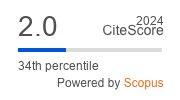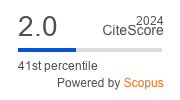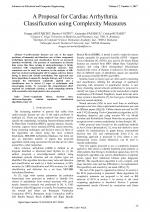| 3/2017 - 4 |
A Proposal for Cardiac Arrhythmia Classification using Complexity MeasuresAROTARITEI, D. |
| Extra paper information in |
| Click to see author's profile in |
| Download PDF |
Author keywords
complexity theory, decision trees, electrocardiography, random sequences, classification algorithms, fuzzy set
References keywords
classification(13), arrhythmia(13), systems(8), fuzzy(7), cardiac(7), biomedical(6), applications(6), analysis(6), algorithm(6), neural(5)
Blue keywords are present in both the references section and the paper title.
About this article
Date of Publication: 2017-08-31
Volume 17, Issue 3, Year 2017, On page(s): 29 - 34
ISSN: 1582-7445, e-ISSN: 1844-7600
Digital Object Identifier: 10.4316/AECE.2017.03004
Web of Science Accession Number: 000410369500004
SCOPUS ID: 85028535223
Abstract
Cardiovascular diseases are one of the major problems of humanity and therefore one of their component, arrhythmia detection and classification drawn an increased attention worldwide. The presence of randomness in discrete time series, like those arising in electrophysiology, is firmly connected with computational complexity measure. This connection can be used, for instance, in the analysis of RR-intervals of electrocardiographic (ECG) signal, coded as binary string, to detect and classify arrhythmia. Our approach uses three algorithms (Lempel-Ziv, Sample Entropy and T-Code) to compute the information complexity applied and a classification tree to detect 13 types of arrhythmia with encouraging results. To overcome the computational effort required for complexity calculus, a cloud computing solution with executable code deployment is also proposed. |
| References | | | Cited By «-- Click to see who has cited this paper |
| [1] S. S. Anand; S. Yusuf; "Stemming the global tsunami of cardiovascular disease", The Lancet, vol. 377, no. 9765, pp. 529-532, 2011. [CrossRef] [SCOPUS Times Cited 182] [2] A. Ebrahimzadeh, A. Khazaee, "An efficient technique for classification of electrocardiogram signals", Advances in Electrical and Computer Engineering, vol. 9, no. 3, pp. 89-93, 2009. [CrossRef] [Full Text] [SCOPUS Times Cited 22] [3] A. Lanatá, G. Valenza, C. Mancuso, E.P. Scilingo, "Robust multiple cardiac arrhythmia detection through bispectrum analysis", Expert Systems with Applications, vol. 38, pp. 6798-6804, 2011. [CrossRef] [SCOPUS Times Cited 53] [4] A. F. Khalaf, M. I. Owis, I. A. Yassine, "A novel technique for cardiac arrhythmia classification using spectral correlation and support vector machines", Expert Systems with Applications, vol. 42, pp. 8361-8368, 2015. [CrossRef] [SCOPUS Times Cited 116] [5] B. M. Asl, S. K. Setarehdan, M. Mohebbi, "Support vector machine-based arrhythmia classification using reduced features of heart rate variability signal", Artificial Intelligence in Medicine, vol. 44, pp. 51-64, 2008. [CrossRef] [SCOPUS Times Cited 341] [6] Y. Özbaya, R. Ceylana, B. Karlikb, "Fuzzy clustering neural network architecture for classification of ECG arrhythmias", Computers in Biology and Medicine, vol. 36, pp. 376-388, 2006. [CrossRef] [SCOPUS Times Cited 223] [7] O. Castillo, P. Melin, E. Ramírez, J. Soria, "Hybrid intelligent system for cardiac arrhythmia classification with Fuzzy K-Nearest Neighbors and neural networks combined with a fuzzy system", Expert Systems with Applications, vol. 39, pp. 2947-2955, 2012. [CrossRef] [SCOPUS Times Cited 99] [8] P. Melin, J. Amezcua, F. Valdez, O. Castillo, "A new neural network model based on the LVQ algorithm for multi-class classification of arrhythmias", Information Sciences, vol. 279, pp. 483-497, 2014. [CrossRef] [SCOPUS Times Cited 127] [9] S. Osowski, T. Markiewicz, L. T. Hoai, "Recognition and classification system of arrhythmia using ensemble of neural networks", Measurement, vol. 41, pp. 610-617, 2008. [CrossRef] [SCOPUS Times Cited 57] [10] C.-H. Lin, Y.-C. Du, T. Chen, "Adaptive wavelet network for multiple cardiac arrhythmias recognition", Expert Systems with Applications, vol. 34, pp. 2601-2611, 2008. [CrossRef] [SCOPUS Times Cited 90] [11] M. Korürek, A. Nizam, "A new arrhythmia clustering technique based on Ant Colony Optimization", Journal of Biomedical Informatics, vol. 41, pp. 874-881, 2008. [CrossRef] [SCOPUS Times Cited 68] [12] J. Park, K. Kang, "PcHD: Personalized classification of heartbeat types using a decision tree", Computers in Biology and Medicine, vol. 54, pp. 79-88, 2014. [CrossRef] [SCOPUS Times Cited 39] [13] E. J. da S. Luz, T.M. Nunes, V. H. C. de Albuquerque, J.P. Papa, D. Menotti, "ECG arrhythmia classification based on optimum-path forest", Expert Systems with Applications, vol. 40, pp. 3561-3573, 2013. [CrossRef] [SCOPUS Times Cited 165] [14] A. K. Mishra, S. Raghav, "Local fractal dimension based ECG arrhythmia classification", Biomedical Signal Processing and Control, vol. 5, pp. 114-123, 2010. [CrossRef] [SCOPUS Times Cited 98] [15] L. Xu, D. Zhang, K. Wang, L. Wang, "Arrhythmic Pulses Detection Using Lempel-Ziv Complexity Analysis", EURASIP Journal on Applied Signal Processing, pp. 1-12, 2006. [CrossRef] [SCOPUS Times Cited 29] [16] J. Pan, W. J. Tompkins, "A real-time QRS detection algorithm", IEEE Trans Biomed Eng., vol. 32, no. 2, pp. 230-236, 1985. [CrossRef] [SCOPUS Times Cited 6508] [17] S. Dash, K. H. Chon, S. Lu, E. A. Raeder, "Automatic Real Time Detection of Atrial Fibrillation", Annals of Biomedical Engineering, vol. 37, no. 9, pp. 1701-1709, 2009. [CrossRef] [SCOPUS Times Cited 283] [18] R. Karlsson, R. Hörnsten, A. Rydberg, U. Wiklund, "Automatic filtering of outliers in RR intervals before analysis of heart rate variability in Holter recordings: a comparison with carefully edited data", BioMedical Engineering OnLine, pp. 1-12, 2012. [CrossRef] [SCOPUS Times Cited 59] [19] J. S. Richman, J. R. Moorman, "Physiological time-series analysis using approximate entropy and sample entropy", American Journal of Physiology, Heart and Circulatory Physiology, vol. 278, no. 6, pp. H2039-H2049, 2000. http://ajpheart.physiology.org/content/278/6/H2039.full [20] D. E. Lake, J. S. Richman, M. P. Griffin, J. R. Moorman, "Sample entropy analysis of neonatal heart rate variability", Am. J. Physiol. Regul. Integr. Comp. Physiol., vol. 283, no. 3, pp. R789-97, 2002. [CrossRef] [SCOPUS Times Cited 1060] [21] A. Lempel, J. Ziv, "On the Complexity of Finite Sequences", IEEE Transactions on Information Theory, vol. IT-22, no. 1, pp. 75-81, 1976. [CrossRef] [SCOPUS Times Cited 2267] [22] J. Ziv, "Coding Theorems for Individual Sequences", IEEE Transactions on Information Theory, vol. IT-24, no. 4, pp. 405-412, 1978. [CrossRef] [SCOPUS Times Cited 138] [23] A. N. Kolmogorov, "Three approaches to the quantitative definition of information", Problems of Information Transmission, vol. 1, pp. 1-7, 1965. [CrossRef] [SCOPUS Times Cited 306] [24] M. R. Titchener, "Generalized T-Codes: An Extended Construction Algorithm for Self-synchronizing Codes", TAMAKI T-CODE PROJECT SERIES, vol. 1, no. 4, pp. 1-8, 1995. [CrossRef] [SCOPUS Times Cited 46] [25] U. Gunter, "Data compression and serial communication with generalized T-codes", Journal of Universal Computer Science, vol. 2, no. 11, pp. 769-795, 1996. [CrossRef] [26] K. Hamano, H. Yamamoto, "A Randomness Test based on T-Complexity", IIECE Trans. Fundamentals, vol. E93, no. 7, pp. 1346-1354, 2010. [CrossRef] [SCOPUS Times Cited 8] [27] Y.-P. Huang, C.-Y. Huanga, S.-I. Liu, "Hybrid intelligent methods for arrhythmia detection and geriatric depression diagnosis", Applied Soft Computing, vol. 14, pp. 38-46, 2014. [CrossRef] [SCOPUS Times Cited 24] [28] H. Xia, I. Asif, X. Xiaopeng Zhao, "Cloud-ECG for real time ECG monitoring and analysis", Computer Methods and Programs in Biomedicine, vol. 110, pp. 253-259, 2013. [CrossRef] [SCOPUS Times Cited 107] [29] The same as [27] [30] X.-S. Zhang, Y.-S Zhu, N. V. Thakor, Z.-Z. Wang, "Detecting Ventricular Tachycardia and Fibrillation by Complexity Measure", IEEE Transactions on Biomedical Engineering, vol. 46, no. 5, pp. 548-555, 1999. [CrossRef] [SCOPUS Times Cited 309] [31] D. Ge, N. Srinivasan, S. M. Krishnan, "Cardiac arrhythmia classification using autoregressive modeling", BioMedical Engineering OnLine, pp. 1-5, 2002. [CrossRef] [SCOPUS Times Cited 214] [32] S. W. Chen, "Two-stage discrimination of cardiac arrhythmias using a total least squares-based prony modeling algorithm", IEEE Trans Biomed Eng, vol. 47, pp. 1317-1326, 2000. [CrossRef] [SCOPUS Times Cited 74] [33] M. H. Song, J. Lee, S. P. Cho, K.J. Lee, S.K. Yoo, "Support Vector Machine Based Arrhythmia Classification Using Reduced Features", International Journal of Control, Automation, and Systems, vol. 3, no. 4, pp. 571-579, 2005. [Online] Available: Temporary on-line reference link removed - see the PDF document [34] T. F. L. de Medeiros, et al. "Heart arrhythmia classification using the PPM algorithm", Biosignals and Biorobotics Conference ISSNIP, pp. 1-5, 2011. [CrossRef] [SCOPUS Times Cited 4] [35] C. Rotariu, V. Manta, R. Ciobotariu, "Integrated system based on wireless sensors network for cardiac arrhythmia monitoring", Advances in Electrical and Computer Engineering, vol. 13, no. 1, pp. 95-100, 2013. [CrossRef] [Full Text] [SCOPUS Times Cited 11] [36] V. Purdila, S.G. Pentiuc, "Fast decision tree algorithm", Advances in Electrical and Computer Engineering, vol. 14, no. 1, pp. 65-68, 2014. [CrossRef] [Full Text] [SCOPUS Times Cited 13] [37] J. Nowaková, M. Prílepok, V. Snase, "Medical Image Retrieval Using Vector Quantization and Fuzzy S-tree", Journal of Medical Systems, Vol. 41, Issue 2, pp. 1-16, Febr. 2017, Plenum Press, New York, USA. [CrossRef] [SCOPUS Times Cited 76] [38] C. Pozna, N. Minculete, R.-E. Precup, L.T. KóCzy, Á. Ballagi, "Signatures: Definitions, operators and applications to fuzzy modelling", Fuzzy Sets and Systems, vol. 201, pp. 86-104, August, 2012. [CrossRef] [SCOPUS Times Cited 94] [39] W. Chen, Z.Wang, H. Xie, W. Yu, "Characterization of surface EMG signal based on fuzzy entropy", IEEE Trans. Neural Syst. Rehabil. Eng., vol. 15, no. 2, pp. 266-272, 2007. [CrossRef] [SCOPUS Times Cited 958] Web of Science® Citations for all references: 0 SCOPUS® Citations for all references: 14,268 TCR Web of Science® Average Citations per reference: 0 SCOPUS® Average Citations per reference: 357 ACR TCR = Total Citations for References / ACR = Average Citations per Reference We introduced in 2010 - for the first time in scientific publishing, the term "References Weight", as a quantitative indication of the quality ... Read more Citations for references updated on 2025-06-30 16:40 in 239 seconds. Note1: Web of Science® is a registered trademark of Clarivate Analytics. Note2: SCOPUS® is a registered trademark of Elsevier B.V. Disclaimer: All queries to the respective databases were made by using the DOI record of every reference (where available). Due to technical problems beyond our control, the information is not always accurate. Please use the CrossRef link to visit the respective publisher site. |
Faculty of Electrical Engineering and Computer Science
Stefan cel Mare University of Suceava, Romania
All rights reserved: Advances in Electrical and Computer Engineering is a registered trademark of the Stefan cel Mare University of Suceava. No part of this publication may be reproduced, stored in a retrieval system, photocopied, recorded or archived, without the written permission from the Editor. When authors submit their papers for publication, they agree that the copyright for their article be transferred to the Faculty of Electrical Engineering and Computer Science, Stefan cel Mare University of Suceava, Romania, if and only if the articles are accepted for publication. The copyright covers the exclusive rights to reproduce and distribute the article, including reprints and translations.
Permission for other use: The copyright owner's consent does not extend to copying for general distribution, for promotion, for creating new works, or for resale. Specific written permission must be obtained from the Editor for such copying. Direct linking to files hosted on this website is strictly prohibited.
Disclaimer: Whilst every effort is made by the publishers and editorial board to see that no inaccurate or misleading data, opinions or statements appear in this journal, they wish to make it clear that all information and opinions formulated in the articles, as well as linguistic accuracy, are the sole responsibility of the author.



